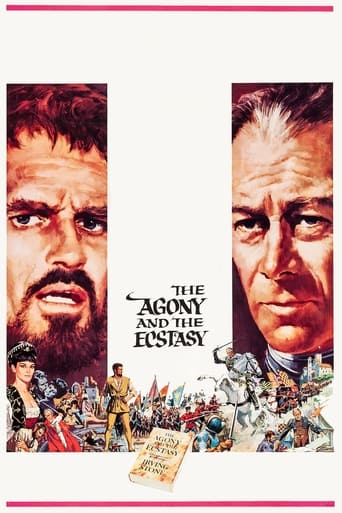


The Agony and the Ecstasy
During the Italian Renaissance, Pope Julius II contracts the influential artist Michelangelo to sculpt 40 statues for his tomb. When the pope changes his mind and asks the sculptor to paint a mural in the Sistine Chapel, Michelangelo doubts his painting skills and abandons the project. Divine inspiration returns Michelangelo to the mural, but his artistic vision clashes with the pope's demanding personality and threatens the success of the historic painting.
-
- Cast:
- Charlton Heston , Rex Harrison , Diane Cilento , Harry Andrews , Alberto Lupo , Adolfo Celi , Venantino Venantini


Similar titles

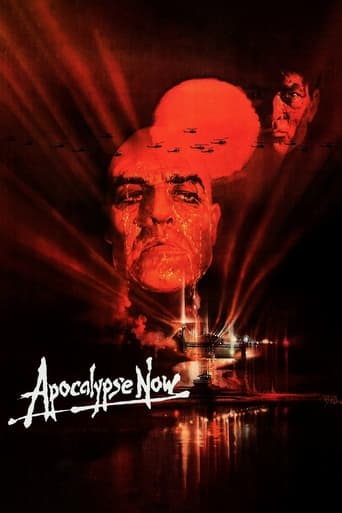

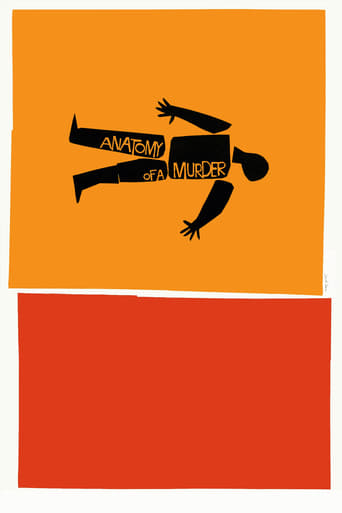
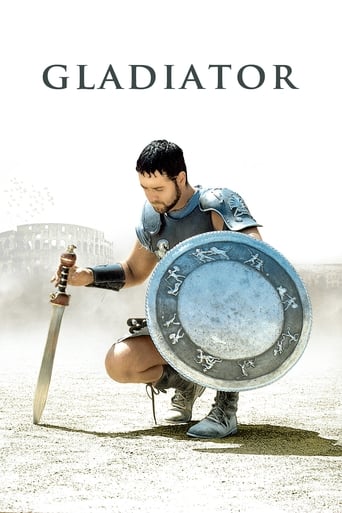
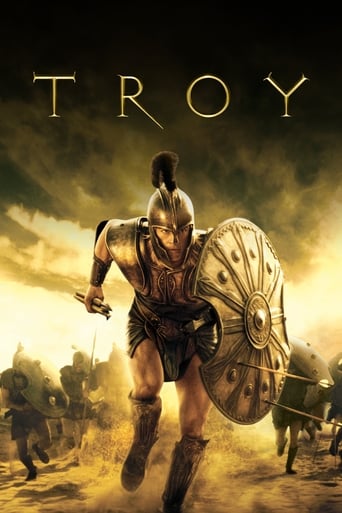



Reviews
Purely Joyful Movie!
How sad is this?
The best films of this genre always show a path and provide a takeaway for being a better person.
One of the worst ways to make a cult movie is to set out to make a cult movie.
(Flash Review)This film paints a picture, pun intended, of the process for how the Sistine Chapel got painted. Pope Julius II commissioned Michelangelo, who was primarily a sculpture, to tackle this impressive frescoes task. Amusing to think Michelangelo's 2nd best trade was painting vs chiseling figures from stone! During the project the two men banter back and forth upon the direction of the frescoes, time it is taking and compensation, which is actually mildly amusing. Pope Julius II is a beast, odd way to describe a Pope, as he still fought in battles on a horse while wearing battle armor. Overall, it doesn't feel as long as it is while it has an epic feel to it. It has some nice historical scenes of the wax and paint dripping in Michelangelo eyes and face and the exhaustive toll it takes on both men. Additionally, the first 15-20 minutes of the film was an actual documentary of the historical Italian art and artists to set the stage for how magnificent the Sistine Chapel truly is.
Copyright 7 October 1965 by International Classics (a wholly-owned subsidiary of 20th Century-Fox). Released through 20th Century-Fox Film Corp. New York opening at Loew's State: 7 October 1965. U.S. release: 7 October 1965. U.K. release: 4 June 1966. London opening at the Astoria, Charing Cross Road: 27 October 1965. Sydney opening at the Paris: 12,568 feet. 140 minutes.SYNOPSIS: Witty, urbane, querulous, pragmatic yet charismatic soldier-pope commissions quarrelsome, rebellious sculptor to paint a ceiling in his Vatican chapel.NOTES: Nominated for five Academy Awards: Color Cinematography (only Shamroy was cited) (lost to Dr Zhivago); Color Art Direction (lost to Dr Zhivago); Sound Recording (lost to The Sound of Music); Original Music Score (lost to Dr Zhivago); Color Costume Design (lost to Dr Zhivago). Negative cost: $12 million. Initial domestic rentals gross: approx. $4 million. Second to The Eleanor Roosevelt Story on the National Board of Review's list of the Ten Best in English for 1965. Filmed from 1 June 1964 to mid-September 1964 in Rome and at locations including Canale de Monterano (for battle sequences) and Todi (for St Peter's Square).COMMENT: What would have been a good film, has been unmercifully padded out to 139 minutes. The fault probably lies not with screenwriter Philip Dunne (who has shown a big improvement of late, cf. Blindfold, which he wrote and directed), but with Irving Stone's original novel. This is evidently aimed at the lowest level of literacy. It depicts Michelangelo as a stubborn, yet dithering iconoclast, who has no interest in his times or the people in it. Therefore, the script displays a corresponding lack of interest. Michelangelo wasn't interested in girls, either. But this would never do for the Italian film industry. And so we are shown Diane Cilento pursuing the hero and his rejecting her for scene after scene after scene of excruciating boredom. Miss Cilento flounders hopelessly in her tawdry lines and ALL her part should be eliminated. This done, the film would receive at least a 75% mark: for Rex Harrison gives a very good performance and Piero Portalupi's beautiful second unit photography is up to his usual high standard. As it stands, however, producer/director Sir Carol Reed (The Third Man, Odd Man Out, A Kid for Two Farthings, Outcast of the Islands) should be ashamed.
This movie is a credit to the producers. It shows the Pope of Rome as human, and as a man who understands his weaknesses and God's greatness. I am a Baptist and hence do not hold to Roman Catholic theology. However, it is fair to say that the two main characters, Michelangelo and Pope Julius do a good job of pointing to the bigness of God and the smallness of man.The movie has some very good statements about God and His sovereignty. The Pope in a weak and humble moment is found by Michelangelo kneeling with a candle at the top of the scaffolding under the panel depicting creation. He asks with awe and wonder about how Michelangelo came to the image of God and man. The Pope then stated, "There is God Who created man, and the artist who was moved to paint the image . . . I am merely a Pope." And he meant "merely a Pope." He understood his smallness. At the end the dying Pope says to Michelangelo, "When I stand before God in judgment, I will place this ceiling in the balance against my sins . . . perhaps it will shorten my time in purgatory." Again, I do not hold to purgatory. But the Pope understood that only those things done for the glory of God will last. Good movie and does honor to history, WITHOUT bad language or sexual content. Good family fare.
Director Carol Reed paints us, the audience, a portrait of the relationship between artist Michelangelo (Charlton Heston) and the Warrior Pope Julius II (Rex Harrison) based on the novel by Irving Stone. Pope Julius II has just commissioned the artist to paint the Sistine Chapel ceiling despite Michelangelo wanting no part of it. The two Renaissance's most colorful figures play a game of cat and mouse, as one is persistent and will not cease until he gets what he wants which is Michelangelo's painting his ceiling. The other figure, Michelangelo is an artist who did not want to paint, stubborn and resisted to all things "normal". He is not stubborn just to be stubborn. He can follow the suggestions of others unless it pertains to art, particularly his art. He knows what he wants and he has reasons for believing that his way will be best. His work on the Sistine Chapel would often bump heads with the strong mind Julius on issues of nudity, and how to portray God's work. The battle of wills fueled by artistic and temperamental differences gives us the audience, a great dramatic historical film. The combination of Michelangelo's varied background as sculptor, painter, poet, architect and engineer, his own personal weaknesses and vanity, and his unremitting drive which enabled him to conquer overwhelming disappointments and find satisfaction in difficult and backbreaking work makes gives the movie its title. Charlton Heston and Rex Harrison are very great in their role as I feel the acting is amazing. Still Charlton Heston feels a bit playing over the top wooden in the role and Rex Harrison is a bit too wordy. The cinematography in the film is breath taking and scenic. I love the scene in which Michelangelo emerged from the cave to find a beautiful sunset giving him his idea for the Sistine Chapel ceiling. It reminds me of how man first came out of the caves dwellings life and into a life of innovative thinking. So Renaissance like. The soundtrack by Alex North is a brilliant score. Oscar nominated work right there. One of the faults of the film is the pace of the movie is very slow to the point, it's snail like. 138 min is the final run time. Historians were quick to point out that the film was even less historically accurate than the Irving Stone bestseller on which it was based. This movie is only a small part of the book and Michelangelo's life. There was a lot of interesting parts left out in order to make the entire movie about the painting of the Sistine Chapel. Yes, Charleton Heston nor Rex Harrison look nothing like Michelangelo or Pope Julius II, but it's true that Michelangelo and Julius were stiff-necked, driven men who use reverse-psychology on each other to get what they want. Another issue about the film is the issue of Michelangelo's sexuality. The movie has Medici's wife in love with him while history states that he might had be homosexual. I know in the 1960's, it would be shocking to see Charleston Heston play a homosexual character, but with all the Homoeroticism art Michelangelo did, it would more historical accurate. In my opinion, it's better to cross out the love story, and focus more on his struggle with the ceiling. The locations scenes in Italy do well in evoking the early 16th Century in Italy. Still, the streets a bit too clean for 16th century Italy. If you are not hooked on historical accuracy and are willing to see Charlton Heston be in pained for several hours, you may enjoy this film. Essential to watch for any art fan.

